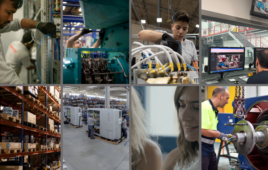
By Hitachi ABB Power Grids
The Environmental Protection Agency’s (EPA) greenhouse gas (GHG) emissions inventory showed the United States produced over 6.6 billion metric tons of carbon dioxide equivalents (MMT CO2 Eq) in 2018. To decrease these emissions, many U.S. states have developed GHG reduction goals. To achieve these goals states will not only have to dramatically increase generation from carbon-free sources, like hydro, wind and solar, but also develop a robust transmission network to get the energy from where it is generated to where it is needed in a reliable and economic way.
Generally, state-level GHG emission goals are to reduce carbon emissions by 40% by 2030 and 80% by 2050, using a 1990 baseline of 6.3 billion MMT CO2 Eq. This means GHG emissions must decrease by over 5 billion MMT CO2 Eq by 2050. Currently, the two largest producers of GHGs in the U.S. are power generation and transportation, with transportation recently passing generation. These two sources account for more than half of the emissions in the U.S.
Reducing emissions from power generation falls on utilities, which need to produce or purchase more carbon-free energy to meet state-level goals. Many utilities have started to implement their own carbon emission reduction goals to meet state reduction deadlines.
Different utilities have different goals, but they are typically one of the following with a timeframe of completion by 2050:
- 100% renewable energy generation
- 100% carbon-free energy generation
- Net carbon zero energy generation

According to the U.S. Energy Information Administration, carbon-free generation resources such as nuclear, hydro, wind, and solar deliver approximately 40% of generation in the United States today, with the other 60% being coal, natural gas and other fossil fuel-based generation. Based on a 2050 target date scenario, that means utilities have about 30 years to offset fossil fuel emissions and/or retire and replace fossil fuel-based generation resources with carbon-free energy generation.
Reducing transportation emissions is focused on transitioning from internal combustion engines to alternatives, like hydrogen and electric vehicles (EVs). Today in the U.S., EVs only makeup 2% of the total vehicles, but this is forecast to grow significantly based on decreasing battery costs, the shift of vehicle manufacturers to EVs, and demand for GHG emission reductions. However, the electrification of transportation extends well beyond personal light-duty vehicles, to include fleets (trains, buses, delivery vans, trucks, airports, shipping ports, taxis, etc.) which are likely to be converted to EVs sooner than personal transport. The vehicles in these fleets have much higher utilization factors and realize greater emission reductions and operations and maintenance (O&M) savings from lower ‘fuel’ consumption and reduced vehicle maintenance. The National Renewable Energy Laboratory (NREL) has forecasted that the transition to EVs will lead to a 20 to 38% increase in electricity consumption for EV chargers by 2050.
The net impact of these changes is an increased load on the power grid, while simultaneously switching 60% of our energy generation away from fossil fuels. We will need substantial investments in our transmission infrastructure to enable this energy transition.

Investing in transmission
To reduce the nation’s carbon footprint and meet GHG emission goals, we need to implement large-scale carbon-free generation resources and reduce the number of internal combustion engines on our roads. Currently, the largest hurdle for this development is modernizing the transmission grid to accommodate electrification and renewable energy generation. Investing in transmission system technology that expands the capacity to transfer energy from areas with favorable conditions for renewable energy development to major load centers and that bridges regional seams is crucial to meeting these goals.
Despite these challenges and large financial investments, de-carbonizing society will create long-term economic, social, and health benefits for the country. As countries, governments, states, provinces and companies contemplate the benefits of moving forward with a de-carbonization agenda, it cannot be accomplished without responsible planning and timely investment in the transmission backbone that allow that energy to flow to where it is most needed. When combined, the potential for transmission investment coupled with renewable energy development can be a powerful contributor to economic growth, job creation and prosperity.
Download the free whitepaperSponsored content by Hitachi ABB Power Grids
Filed Under: Sponsored Content




